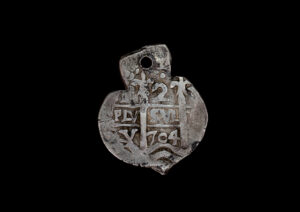
Rare 1704 Potosi Bolivia 2 Reales Heart Shaped “Corazón” – Double Dated!
Item #CC-0181 | Rare 1704 Potosi Bolivia 2 Reales heart Shaped “Corazón” – Double Dated!
Mint: Potosi, Bolivia
Assayer: Y for “Diego de Ybarbouro”
Ruler/Period: King Philip V
Grade: Uncertified
Weight: 5.71 Grams
Description: This is a unique example of a Potosi 2 Reales that was shaped as a heart. Coins shaped like this are known in Spanish as Corazón’s and were typically struck from a unique die and planchet that provided the extended portion at the top of the coin to allow for a hole to be punched or drilled so they could be worn. This coin appears to have been worn as a pendent and based on its wear, it was likely worn for some time, which may account for some of its missing details and weight. Typically, 2 reales from this period should weigh around 6.7 grams, which makes this coin slightly underweight.
Sewall Menzel, author of “Cobs, Pieces of Eight and Treasure Coins” published by the American Numismatic Society in 2004, states the following about heart shaped cobs (text copied from page 33):
“Silver cobs were sometimes deliberately shaped into hearts at the Potosi mint. Like the presentation pieces, they can be found in all of the different denominations with the exception of the quarter real pieces. In each case the flan was carefully cut or sheared into the desired shape. Mint standards for weight, metallic content, and design work were adhered to in most cases.
The heart shaped pieces were apparently made to support church related activities and were awarded for scholastic and other achievement on the part of students in monastic orders and schools. They may also have served the purpose of votives. My own research involving church officials in Europe and in Bolivia at Potosi, indicates that the Sacred Heart of Jesus, a symbol of some significance in the Catholic Church of Spanish colonial times, was indeed used as a form of reward. There was no romantic significance intended for these special productions, although private parties could have used them for that purpose. All hearts are pierced for wear as an adornment. Because genuine heart shaped cobs command a high premium, numerous copies in counterfeits are known to exist.
Heart shaped cobs in all denominations from ½ real to eight reales were produced intermittently at Potosi from as early as 1664 to about 1759 and are known to have come primarily from this mint. The obverse and reverse of each piece were normally aligned carefully along the vertical or horizontal axis of the respective designs. The upper protrusion of most pieces tends to extend well beyond the standard issue planchet (as is with this piece). This necessitated special striking with full dies. The struck piece was then fashioned into the shape of a heart and pierced as appropriate. Weights for the heart pieces often vary as much as a half to a full gram over or under the officially prescribe weights (which is consistent with this piece).”
The first National Mint of Potosí was located in Bolivia and was part of the Viceroyalty of Lima – a territorial entity located in South America, a member of the Spanish Crown between the 16th and 19th centuries. It was one of the most important mints, which was built thanks to the abundant veins of silver from the Cerro Rico of the so-called Villa Imperial.
For more detailed information on heart shaped cobs, see the article written by Daniel Sedwick titled “Hearts of Potosi” at https://www.sedwickcoins.com/articles/hearts.htm
For more information on the Potosi mint and Corazón’s minted there click here
This is a wonderful and rare artifact that is perfect for any collector of Spanish Colonial silver or pirate treasure!

